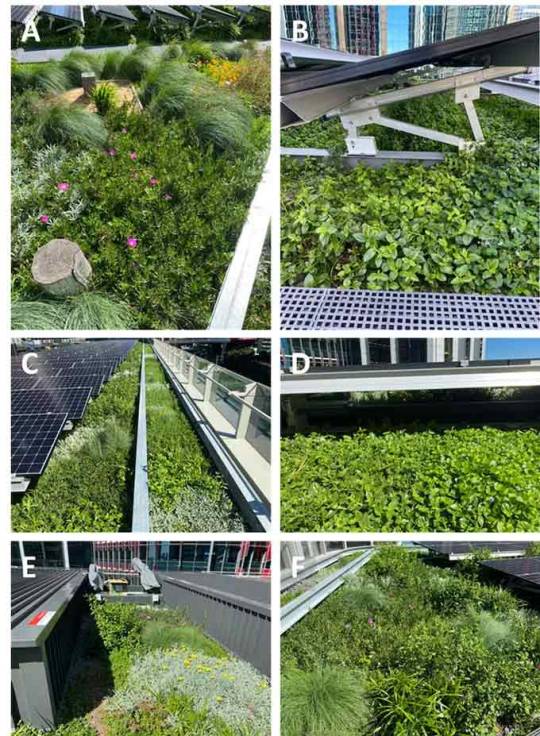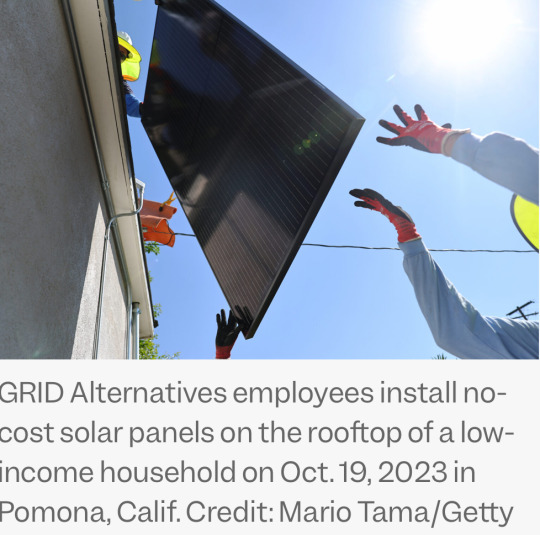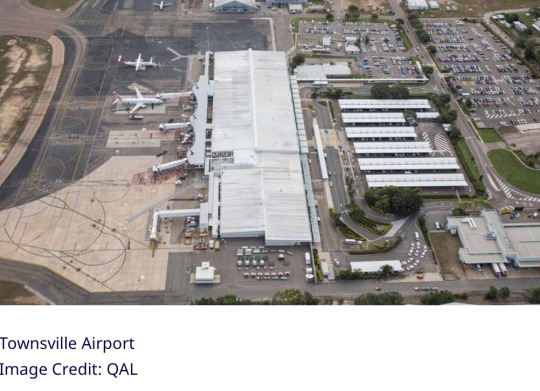#Rooftop Solar
Explore tagged Tumblr posts
Text
"As solar panels heat up beyond 25°C, their efficiency decreases markedly. Green roofs moderate rooftop temperatures. So we wanted to find out: could green roofs help with the problem of heat reducing the output of solar panels?
Our research compared a “biosolar” green roof — one that combines a solar system with a green roof — and a comparable conventional roof with an equivalent solar system. We measured the impacts on biodiversity and solar output, as well as how the plants coped with having panels installed above them.
The green roof supported much more biodiversity, as one might expect. By reducing average maximum temperatures by about 8°C, it increased solar generation by as much as 107% during peak periods. And while some plant species outperformed others, the vegetation flourished.
These results show we don’t have to choose between a green roof or a solar roof: we can combine the two and reap double the rewards...
How did the panels affect the plants?
In the open areas, we observed minimal changes in the vegetation cover over the study period compared to the initial planted community.
Plant growth was fastest and healthiest in the areas immediately around the solar panels. Several species doubled in coverage. We selected fast-growing vegetation for this section to achieve full coverage of the green roof beds as soon as possible.
The vegetation changed the most in the areas directly below and surrounding the solar panels. The Baby Sun Rose, Aptenia cordifolia, emerged as the dominant plant. It occupied most of the space beneath and surrounding the solar panels, despite having been planted in relatively low densities.
This was surprising: it was not expected the plants would prefer the shaded areas under the panels to the open areas. This shows that shading by solar panels will not prevent the growth of full and healthy roof gardens.

What were the biodiversity impacts?
We used environmental DNA (eDNA) surveys to compare biodiversity on the green roof and conventional roof. Water run-off samples were collected from both roofs and processed on site using portable citizen scientist eDNA sampling equipment to detect traces of DNA shed by the species on the roof.
The eDNA surveys detected a diverse range of species. These included some species (such as algae and fungi) that are not easily detected using other survey methods. The results confirmed the presence of bird species recorded by the cameras but also showed other visiting bird species went undetected by the cameras.
Overall, the green roof supported four times as many species of birds, over seven times as many arthropods such as insects, spiders and millipedes, and twice as many snail and slug species as the conventional roof. There was many times the diversity of microorganisms such as algae and fungi.
Encouragingly, the green roof attracted species unexpected in the city. They included blue-banded bees (Amegilla cingulata) and metallic shield bugs (Scutiphora pedicellata).
How did the green roof alter temperatures?
The green roof reduced surface temperatures by up to 9.63°C for the solar panels and 6.93°C for the roof surfaces. An 8°C reduction in average peak temperature on the green roof would result in substantial heating and cooling energy savings inside the building.
This lowering of temperatures increased the maximum output of the solar panels by 21-107%, depending on the month. Performance modelling indicates an extensive green roof in central Sydney can, on average, produce 4.5% more electricity at any given light level.
These results show we don’t have to choose between a green roof or a solar roof. We can combine them to take advantage of the many benefits of biosolar green roofs.
Biosolar roofs can help get cities to net zero
The next step is to design green roofs and their plantings specifically to enhance biodiversity. Green roofs and other green infrastructure may alter urban wildlife’s activities and could eventually attract non-urban species.
Our green roof also decreased stormwater runoff, removed a range of run-off pollutants and insulated the building from extremes of temperature. A relatively inexpensive system provides all of these services with moderate maintenance and, best of all, zero energy inputs.
Clearly, biosolar green roofs could make major contributions to net-zero cities. And all that’s needed is space that currently has no other use."
-via GoodGoodGood, May 12, 2024
#green#green roof#biosolar#solar power#solar panels#rooftop solar#solarpunk#native plants#australia#sydney australia#biodiversity#conservation#climate change#climate action#climate hope#global warming#temperature#climate adaptation#cooling#good news#hope
2K notes
·
View notes
Text
Dandelion News - December 8-14
Like these weekly compilations? Tip me at $kaybarr1735 or check out my Dandelion Doodles for 50% off this month!
1. Rooftop Solar Keeps Getting More Accessible Across Incomes

“The long-term trend is that the median income for a household with rooftop solar is getting closer almost every year to that of the median income for owner-occupied households.”
2. Endangered seabirds return to Pacific island after century-long absence

“"No native species were harmed during the removal of invasive rats from Kamaka Island,” Esposito said. […] The team also collected and planted native sedges and grasses while removing invasive trees to enhance nesting conditions.”
3. First-of-its-kind crew welfare measure adopted at Pacific fisheries summit

“The new measure establishes minimum standards on board, including access to clean food and water, medical care, and sleeping quarters. It stipulates that workers have “unfettered access” to their identity documents […] and “unmonitored access to communication devices to seek assistance.””
4. Greyhound racing is increasingly rare worldwide. New Zealand now plans to outlaw the practice

“New Zealand’s government rushed through a law to prevent dogs from being killed while the industry winds down, unless a veterinarian deems it unavoidable. This will prevent owners from euthanizing dogs for economic reasons, Peters said.”
5. Possible Win-Win for Wildlife Management and Food Security
“Wild-harvested meat donation programs can help improve food insecurity while also helping manage overabundance of wildlife species like white-tailed deer[…. In one program,] hunters donated 600,000 meals. But that’s only 5.7% of the amount of venison that food donation facilities could use, according to the Food Bank Council of Michigan. The researchers say this suggests there’s room for scaling up these programs.”
6. Poll of American Farmers Shows Strong, Widespread Support for Increased Farm Bill Conservation Funding

“The polling, which surveyed over 500 farmers and ranchers across the country, found broad support for continuing and increasing funding for climate-smart agriculture conservation programs.”
7. Long-distance friendships enhance trust in conservation efforts

“Relative to a person with no long-distance friends, having even just one friend in another village led to a 15% increase in conservation activities such as beach cleanups, reporting illegal fishing practices and educating others about sustainable resource management.”
8. Two major Sunshine State airports make switch to 100 pct renewables

“Power for operations ranging from lighting and air conditioning to escalators and charging stations will be provided from renewable energy projects [...] at the beginning of 2025, ensuring clean energy operations for the more than 8 million passenger journeys averaged each year.”
9. Expansion of federally subsidized public housing may offer a path out of LA's homelessness crisis

“[… A] half-cent sales tax [was] recently approved by L.A. County voters expected to generate $1 billion per year to address homelessness. […] “Metros with higher concentrations of federally financed public housing tend to have lower rates of unsheltered homelessness," Schachner said.”
10. $20 Million Available to Advance Habitat Restoration Priorities of Tribes and Underserved Communities

“Through this funding, NOAA will help support community-driven habitat restoration and build the capacity of tribes and underserved communities to more fully participate in restoration activities.”
December 1-7 news here | (all credit for images and written material can be found at the source linked; I don’t claim credit for anything but curating.)
#hopepunk#good news#solar#solar panels#solar power#rooftop solar#income inequality#low income#birds#conservation#invasive species#human rights#workers rights#fishing#dogs#greyhound#tw dog death#tw pet death#dog racing#hunting#farmers#climate#climate action#community#renewableenergy#airport#unhoused#homelessness#noaa#habitat restoration
66 notes
·
View notes
Text



Excerpt from this story from Inside Climate News:
8 notes
·
View notes
Text

2024. gadā kopējā elektroenerģijas bilancē būtiskāku lomu ieņēmusi saules enerģija. 2024. gadā sadales sistēmā no saules saražotas (un kopējā tīklā nodotas) teju 400 gigavatstundas (GWh) elektroenerģijas, kas ir trīs reizes vairāk nekā 2023. gadā iespēts.
The total solar generation capacity in Latvia reaches 660 MW
In 2024, solar energy will play a more significant role in the overall electricity balance. In 2024, almost 400 gigawatt-hours (GWh) of electricity was produced from the sun in the distribution system (and transferred to the common network), which is three times more than what was possible in 2023(..)
P.S. Latvia and the other countries of the Baltic Sea region are rapidly reducing their dependence on fossil fuel imports...
Contrary to the uproar and hysteria created by the corrupt American and Russian click-bite media, in the Baltic sea region we actually HAVE PLENTY OF OUR OWN domestic energy resources that reduce the negative consequences of the chaos of the fossil fuel market...
#Latvia#solar power#renewable energy#energy safety#energy independence#defense of freedom#solar farm#rooftop solar#independence#russian defeat
3 notes
·
View notes
Text
32 notes
·
View notes
Text
In recent years, customer complaints about rooftop solar have increased. Across the country, prosecutors are investigating high-pressure sales tactics and misleading financing arrangements. Some customers say they were victims of fraud and forgery. The Consumer Financial Protection Bureau recently warned solar customers about hidden fees and deceptive statements about the financial benefits of solar. But what if you want solar now? Here are some things to consider.
3 notes
·
View notes
Text
Holy Shit! If you see a door to door solar salesman, grab your shotgun!
21 notes
·
View notes
Text
In 2015, two geographers noticed solar panels popping up on houses in their small US state of Connecticut. Curious, they set out to see if they could figure out what predicted who had them. Would they be in richer homes? Or in areas with higher population density?
Early adopters of solar panels tend to be people who are interested in innovative technology, who find an installer they trust, and who think having solar panels will benefit them. But once an early adopter made their choice, the geographers found, a cluster would spring up around them. Having solar panels on a house near you, where you could see them and talk to a real live person who had them, it turned out, was the biggest predictor of whether you’d get them yourself.
Why? Because it brought down the “cost” of information. You didn’t have to go somewhere or find a new person to talk to; they were right there beside you and ready and eager to bend your ear with all the information you needed to make the same choice they had.
#article#climate change#climate crisis#climate doom#climate science#solar punk#solarpunk#rooftop solar#solar panel#collective power#collective action
19 notes
·
View notes
Text
youtube
Can Solar Rooftops Power the World? Growing the world’s renewable energy capacity has always been a delicate balancing act, and one of the many plates we have to spin during that act is land use. Utility-scale solar and wind parks are rapidly expanding in size and prevalence all over the world. But it’s not just NIMBYism that complicates the creation of clean energy — it’s serious environmental and social concerns, too. When are the negative impacts of siting these massive projects worth the benefits? When are they not? Could rooftop solar single-handedly provide us all the energy we need while avoiding legal hassles and ecological consequences? Do we have enough space for solar?
Watch Why This Window Heat Pump Is Genius • Why This Window Heat P...
Check out the mentioned videos:
Solar Panels Plus Farming? Agrivoltaics Explained • Solar Panels Plus Farm...
How Solar Panels Can Help Solve California's Drought • How Solar Panels Can H...
The Genius of Small Hydro Turbines • The Genius of Small Hy...
Video script and citations:
https://undecidedmf.co...
Get my achieve energy security with solar guide:
https://link.undecided...
Follow-up podcast:
Video version - / @stilltbd
Audio version - http://bit.ly/stilltbdfm
#undecided with Matt Ferrell#solarpunk#soalr panels#solar energy#solar power#green energy#clean energy#renewable energy#rooftop solar#Youtube
2 notes
·
View notes
Text

Sustainable solar power generation is viable in almost all parts of #Gujarat.
Let us try to achieve a greener Gujarat from today. Greenbeam Call: +91 0261-3504197
Email: [email protected]
0 notes
Text
"Passed in February [2024], a massive subsidy program to help Indian households install rooftop solar panels in their homes and apartments aims to provide 30 gigawatt hours of solar power to the nation’s inventory.
The scheme, called PM-Surya Ghar, will provide free electricity to 10 million homes according to estimates, and the designing of a national portal���a sort of Healthcare.gov for solar panels—will streamline the process of installation and payment.
The program was cooked up because India had fallen woefully behind on its planned installations for rooftop solar. In many parts of the subcontinent, the sun is absolutely brutal and relentless, but by 2022, Indian rooftop solar power generation topped out at 11 gigawatts, which was 29 gigawatts under a national target set a decade ago.
Part of the challenge, Euronews reports, is that approval from various agencies and departments—as many as 21 different signatures in some cases—was needed to place a solar array on your house. Aside from this bureaucratic nightmare, the cost of installation was often higher than $5,000; more than half the average yearly income for a working Indian urbanite.
Under PM-Surya Ghar, subsidies for a 2-kilowatt solar array will cover as much as 60% of the installation costs, falling to 40% for arrays 3 kilowatts or higher. Loans set at around 7% interest rates will help families in need get started. 750 billion Indian rupees, or $9 billion has been set aside for the project.
Even in New Delhi, which can be covered in clouds and smog for days, solar users report saving hundreds during summer time on their electricity costs, with one apartment shaving $700 every month off energy bills.
PM-Surya Ghar is also seen as having the potential to cause a boom in the Indian solar market. Companies no longer have to go running around for planning and permitting requirements, and the government subsidies ensure their customer base can grow beyond the limits of household income."
-Good News Network, April 10, 2024
#india#new delhi#solar#solar panels#clean energy#solar power#renewables#rooftop solar#climate policy#climate action#climate hope#renewable energy#good news#hope
272 notes
·
View notes
Text
Want to get Rooftop solar system for your home? Learn more about rooftop solar system price in India, benefits, working, components & more.
#rooftop solar system#rooftop solar#solar system#solar#solar energy#solar for home#home solar#home solar system
0 notes
Text
Excerpt from this story from Inside Climate News:
The growth of customer-owned solar and batteries can help to reduce wear and tear on the grid and save ratepayers money.
How much money? A new paper from University of Texas at Austin researchers shows savings of about 40 percent.
The lead author, Nick Laws, has experience translating his area of research into terms that regular people can understand. If he’s at a backyard picnic, he said, he’ll begin by pointing at overhead power lines.
“If you look at these wires and poles around us, they’re actually, in most cases, very old,” he said. “A lot of times the hardware on the grid is near the end of life.”
The paper is the culmination of his doctoral dissertation, completed in December, about extending the life of grid hardware by reducing the stress caused by periods of high electricity demand and long-term growth in demand. He and his colleagues looked at how best to encourage companies and individuals to invest in energy systems that help to diminish demand on the grid.
The utility-speak term for these systems is “non-wires alternatives,” which can include rooftop solar, community solar and battery storage.
It also includes electric vehicle charging systems, but only if the equipment is connected to the grid in a way that allows a grid operator to pause charging or draw electricity from the car’s batteries at times of high demand.
Another important resource is demand response, which usually applies to factories and other major electricity users who agree to reduce their power use at times of high demand.
Laws’ paper simulates the effects of electricity demand on a neighborhood-size part of the grid over 20 years.
His model found that the costs of providing electricity would be $7.2 million per year if there was no battery storage or other customer-owned resources to reduce demand. This takes into account many variables, including high market prices of electricity during times of strong demand and the need to buy new equipment such as wires and transformers.
Next, he looked at the costs if there were optimal incentives to get households and businesses to invest in demand-reducing tools. He estimated the costs, including the incentives, at about $4.2 million per year.
The savings, which would be passed on to consumers through their utility bills, is about $3 million, which is about 40 percent.
“It lowers the cost for everybody,” Laws said.
I want to call attention to my use of the term “optimal incentives” above because that’s a vital part of the analysis. Much of the paper considers how to calculate incentives, which would involve the utility or grid operator paying customers for using equipment that reduces electricity demand. The price would vary based on how valuable that reduction is.
4 notes
·
View notes
Text
youtube
US solar industry explodes past pivot point with incredible exponential growth
P.S. Good news! Rising solar industry means Russian and Trump's defeat! No need for fossil fuel imports: Russians, Muslim terrorists and Trump have no money...and the civilized free world has far less problems...
#USA#solar power#renewable energy#russian defeat#trump's defeat#energy independence#solar farm#rooftop solar#Youtube
3 notes
·
View notes
Text
1 note
·
View note
Text
Why Choose a Rooftop Solar Solutions Provider for Your Energy Needs?
A rooftop solar solutions provider offers expert guidance to help you harness clean, renewable energy. These professionals design and install systems tailored to your needs, ensuring optimal performance and long-term savings. By partnering with a reliable company, you gain access to high-quality solar panels, efficient installation, and ongoing maintenance services.

Switching to rooftop solar reduces electricity bills, promotes eco-friendly living, and increases property value. Expert providers make the process seamless, from consultation to installation, so you can enjoy hassle-free energy independence.
Choose a trusted solar solutions provider today and take the first step toward a sustainable future!
0 notes